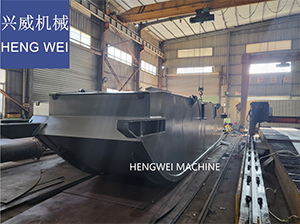Pontoon and Amphibious Excavator Enhancing Efficiency in Water-based Construction
Water-based construction projects require specialized equipment that can operate effectively in aquatic environments. Pontoon platforms and amphibious excavators have emerged as innovative solutions to overcome the challenges faced in such projects. This article explores the capabilities and advantages of these machines in revolutionizing water-based construction operations.
Amphibious Excavator Floating Pontoon Platforms: Versatile Docking Solutions:
Amphibious excavator floating pontoon platforms provide stable and versatile docking solutions for water-based construction projects. These floating structures can support heavy machinery, equipment, and personnel, enabling efficient operations in water bodies. With modular designs and customizable configurations, pontoons offer flexibility to adapt to different project requirements, making them indispensable for activities like bridge construction, dredging, and marine infrastructure development.
Amphibious Excavators: Seamless Transition between Land and Water:
Amphibious excavators are specifically designed to operate seamlessly in both land and water environments. These machines feature specialized tracks or pontoons that enable them to navigate through wetlands, marshes, and shallow waters. The ability to transition between land and water with ease makes amphibious excavators the ideal choice for applications such as wetland restoration, shoreline construction, and beach nourishment projects.
Advantages of Amphibious excavator floating pontoon and Amphibious Excavator Technology:
a) Efficiency and Productivity: Pontoon platforms and amphibious excavators improve project efficiency by eliminating the need for additional equipment and reducing transportation time between land and water work areas.
b) Accessibility: These machines provide access to remote or inaccessible areas, enabling construction projects at locations that were previously challenging or costly to reach.
c) Environmental Considerations: Pontoon platforms and amphibious excavators minimize environmental impact by reducing ground disturbance and enabling construction activities in sensitive ecosystems without harming natural habitats.
d) Safety: Both machines offer enhanced safety features, including stability in varying water conditions and improved operator visibility, ensuring a secure working environment.
Real-world Applications:
Amphibious excavator floating pontoon platforms and amphibious excavators have demonstrated their effectiveness in numerous water-based construction projects worldwide. Examples include the construction of bridges over water bodies, land reclamation for infrastructure development, environmental restoration projects in wetlands, and maintenance of waterways. These technologies have proven to be efficient, cost-effective, and environmentally conscious solutions for challenging construction activities.
Continuous Innovations:
Manufacturers are investing in research and development to further enhance the capabilities of pontoon platforms and amphibious excavators. Advancements in materials, propulsion systems, and control technologies continue to improve their performance and adaptability. Customization options are also available, allowing these machines to be tailored to specific project requirements, maximizing productivity and efficiency.
Conclusion:
Amphibious excavator floating pontoon platforms and amphibious excavators have revolutionized water-based construction projects by offering efficient alternatives to traditional equipment. The versatility, accessibility, and environmental advantages provided by these machines have made them essential in the construction industry. As technology evolves, we can expect further innovations, making pontoon platforms and amphibious excavators even more versatile and sustainable for future water-based construction endeavors

